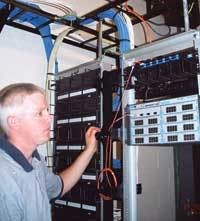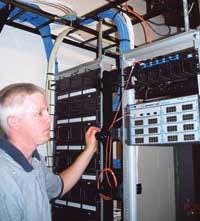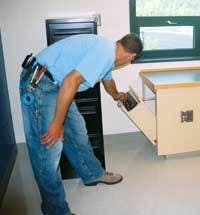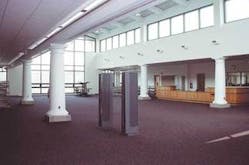Despite numerous project challenges, a new Connecticute high school scores with gigabit-to-the-desktop connectivity
Designing and implementing a network cabling infrastructure in public school districts present a host of challenges, spanning from budgets and bidding to final implementation. Amidst such challenges, however, a contractor and a Connecticut school district’s network administrator have relied on TIA standards and strategic solutions to implement a high performance LAN at a new 234,000-sq. ft. high school in Tolland, CT-a community of more than 13,000 residents located 20 miles northeast of Hartford.
A chance to upgrade
In recent years, the town has experienced a burst in residential growth, and subsequent enrollment predictions called for construction of a new high school. “When the town looked at the capacity of the existing high school, they realized that it wouldn’t meet the requirements under state law,” says John Stake, network administrator for the Tolland school district.
Based on a town profile, 40% of the $56.6 million in construction costs for the new high school were to be reimbursed through state funding. The planned construction also gave the school district an opportunity to upgrade the high school’s network infrastructure. A Category 5e network with 100-Mbit/sec to the desktop and gigabit-speed backbone connectivity was sufficient for internal applications and usage within the old high school, but for the new school’s network, other concerns had to be addressed.
“From the old school, a direct fiber link to the Connecticut Education Network (www.cen.ct.gov) provided the potential for high-speed access to the Internet, but because the equipment was outdated, that connection was underutilized,” notes Stake. Via fiber-optic links, the Connecticut Education Network provides the state’s libraries and education institutions with high-speed access to the Internet, the Internet2 network, and the state’s digital library. Stake continues, “Building a new school gave us the opportunity to purchase new equipment that can maximize the bandwidth available.”
The old school, built in the 1960s, not surprisingly, wasn’t designed to accommodate today’s technology. “When we started using computers in the classroom at the old school, the classrooms had to be retrofitted with data wiring, which usually meant a single data drop per room,” explains Stake. “As usage grew, we had to locate a small switch in the classroom to enable more PCs, while avoiding the expense of adding more cabling; however, that meant sharing the 100 Mbit/sec connection back to the closet. Also, our network servers were reaching the end of their storage capacity.”
In designing the new high school’s network, the district’s technology objective was to ensure that existing applications and usage could be supported, while incorporating more square footage and additional workstations. As technology has evolved, the new school also features more disk space and faster network equipment for delivering gigabit speeds to the desktop.
“The demand won’t be much greater to start, but now applications will be much quicker at the PC level, with the new equipment providing room to grow,” says Stake. “The better technology wasn’t something we had to push for; it just came with the territory, because that’s where technology is today. When you’re making an investment for new construction, you buy what’s currently available-and PCs and switches today are all at least gigabit-speed, and come at affordable prices.”
A competitive public bid
The network infrastructure design was developed by a technology consultant and then sent out for public bid. American Networks International (ANI; www.americannetworks.com) of New Britain, CT was awarded the bid, primarily on price.
“In public education, the dollar is huge, and the biggest challenge is the bid itself,” says Jack Pragosa, VP of operations for ANI. “When you enter in the arena of public bidding, you’re in a competitive situation with several other contractors of different levels, including the small ‘mom and pop’ organizations with low overhead. The challenge then is producing a competitive bid that meets the specifications and delivers a quality project to the customer, while making enough profit.”
According to Pragosa, municipalities’ “prevailing wage” jobs can also present difficulty in public bidding scenarios. “In Connecticut, any public project over $100,000 must be paid with the prevailing wage in that district,” he explains. “Prevailing wages can often be higher, and the process involves detailed, certified paperwork. It’s public money, town money-it’s not a cut-and-dried private contract.”
To meet pricing for the project, ANI’s bid incorporated fiber and copper cabling from Berk-Tek (www.berktek.com) and Hubbell Premise Wiring’s (www.hubbell-premise.com) patch panels, data and multimedia connectors, and stainless steel faceplates. The system was certified and received a 25-year warranty. “If the cable and connectivity solutions both meet the standards and the specifications for the performance, there’s no reason why they can’t be partnered together. It’s interoperability at its finest, and that’s the whole point of the standards,” says ANI’s Pragosa. “In this particular bid, price was the deciding factor.”
The new high school’s network infrastructure includes a demarcation point located on the building’s first floor and a second-floor main data center, housing Hewlett Packard servers and switches, located behind the school’s library/media center. From the demarcation point back to the old school, ANI installed 6,000 feet of Berk-Tek’s Adventum loose tube singlemode fiber, 4,000 feet of which was aerial fiber. From the main data center, 12 strands of 50-µm laser-optimized fiber connect to five telecommunications rooms (TRs) located throughout the building.
Category 6 cabling was used to provide a total of 1,560 data drops, including extra drops for future wireless access points (WAPs), which were ultimately removed from the present scope of the project due to budgetary constraints. (In the interim, the school employs a portable WAP and laptop PCs that are moved from classroom to classroom as needed.) All horizontal cables running from the TRs to the workstations are bundled and supported in 12 x 2-inch basket tray that traces the facility’s main corridors above a drop ceiling.
The school’s science and computer labs provide network connections at each workstation. Standard classrooms include a teacher’s workstation with two Category 6 connections and additional connections to support student PCs. Overhead projectors in each classroom connect to the teacher’s workstation via coax jumpers, with Hubbell’s RCA jacks connecting to amplifiers and speakers mounted in the ceiling. Additional amplifiers and multimedia equipment are implemented in the school’s auditorium and music rooms.
“Teachers can simultaneously display through their PC to the overhead projector,” says Stake. “We also have a multimedia component of the network that uses its own server to distribute audio, video, and cable TV to the desktop over IP. This enables us to broadcast to every teacher location as needed.”
One of the school’s five TRs, which was originally intended for use as a maintenance storage area, now houses network equipment and cross-connects in two freestanding cabinets. “During installation, we realized that the drawings were incorrect and horizontal cabling distances were being exceeded,” explains Mark Baker, project field foreman for ANI. “We, therefore, had to add the cabinets to an existing storage room.”
But adding the cabinets was not without challenges. “Because the closet was originally designed for storage, power and cooling were inadequate; we had to retrofit,” notes Stake. “As it turns out, the cabinets support 323 data drops, which is more than any other TR. Because it’s so densely populated, we needed to find ways to keep it neat and organized.”
Stake and his team coordinated the switch ports in the densely populated cabinets with the labeling scheme on the patch panels. To further facilitate port identification, Stake chose Patchsee’s (www.patchsee.com) copper patch cords, which feature built-in light identification. Light is transmitted via two plastic optical fibers running through the length of these cables. Light injected at one end of the patch cord identifies the other end via two luminous dots; because the light transmission is optical, it does not disturb the system’s electrical performance.
Lessons learned
According to Stake, the new high school project confronted several additional challenges that resulted in numerous lessons being learned. For example, limited coordination between the network’s technology and the school’s furniture designs resulted in several data and power connections not being properly located in relation to the furniture’s layout. “We discovered just a few weeks before school started that one classroom had 8-foot tall cabinets where we had anticipated putting two network printers,” explains Stake. “Now we have to use one of the teacher’s data drops and split it with a mini switch to accommodate the printers. The solution works, but it’s not something that should have happened in new construction.”
Also, while some of the school’s computer labs employ Hubbell Premise Wiring’s poke-thru devices for power and data connections in the floor, other areas relied on connections unsuitably located on a wall to support rows of PCs.
“Power and data should have been delivered to the middle of the rows or incorporated into the furniture, but instead, 12 power receptacles and six data connections were installed on the wall at one end of the row,” says Stake. “Only the power cord of the first PCs can reach the receptacles, so we had to use extension power strips to deliver power to the rest of the row. That means using only two or three of the 12 power receptacles.”
The district also had to buy special length patch cords to reach the furthest PCs, which elicited concern about exceeding the design’s 100-meter channel length and effects on performance. “Fortunately, the cable runs turned out to be short enough to accommodate the long patch cords,” says Stake.
Stake and his team also called for several changes that never made it to the final technology drawings, due to a process involving a lengthy chain of command that included construction management, a general contractor, an architect, engineers, and a technology consultant. “We went through the drawings over and over again, so you can imagine our frustration to find that crews were using drawings that didn’t show our changes,” says Stake. “Thankfully, ANI was easy to work with, and they were able to catch many of the issues.”
Notes ANI’s Pragosa, “The issues with the drawings ended up adding over $100,000 worth of changes to the project. There was a lot of engineering that had to be done in the field, and I give Mark Baker a lot of credit for leading the project.”
“In hindsight, if we could do it over, we would have requested regular meetings with the technology consultant and engineers to go over drawings and make sure that changes were made,” admits Stake. “Somewhere in the lengthy chain of command, changes got lost. Perhaps if the technology, furniture, and engineering all fell under one entity, oversights could have been avoided.”
In the end, however, the Tolland High School project provided students and faculty with more square footage, an updated facility, and a high performance LAN with gigabit-to-the-desktop capability. Concludes Stake, “Luckily, in the overall scheme of the project, problems were few, and we were able to implement strategies and special technologies to overcome the challenges.”BETSY ZIOBRON is a freelance writer covering the cabling industry, and a frequent contributor to Cabling Installation & Maintenance. She can be reached at: [email protected]



